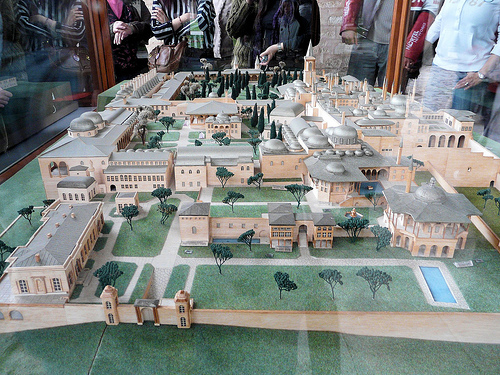Harem
 Harem
was a tradition living quarters of Sultan's many wives,
concubines and numerous children. It is a labyrinth of several beautiful rooms
with exquisite decorations those construction started in
16th century by the orders of Murat III. Only male slave servants known as
eunuchs were allowed to enter these quarters. It is one of
the popular travel destinations in Topkapi Palace so book your
ticket early if you want to get there. Harem
was a tradition living quarters of Sultan's many wives,
concubines and numerous children. It is a labyrinth of several beautiful rooms
with exquisite decorations those construction started in
16th century by the orders of Murat III. Only male slave servants known as
eunuchs were allowed to enter these quarters. It is one of
the popular travel destinations in Topkapi Palace so book your
ticket early if you want to get there.
|
Divan
Divan was a special chamber in the Topkapi
Palace. It was here that viziers (state high officials)
would met in this room. The catch of Divan was in a fact
that sultan or ruler of Topkapi Palace could watch and
listen to their deliberations.
|
Baghdad
Pavilion
Baghdad Pavilion was added in 1639 by Ottoman
sultan Murat IV to celebrate the capture of Baghdad by the
Ottoman Turkish forces. Its interior has beautiful white and
blue tiles that cover its walls.
|
Gate of
Salutations
Gate of Salutations is the official entrance
to the Topkapi Palace. |
The Gate of Felicity
The Gate of Felicity is also referred as the
Gate of the White Eunuchs. |
Iftariye
Pavilion
This beautiful building of Topkapi Palace
offers a great view of the Golden Horn from its balcony. |
Library of
Ahmet III
Library of Ahmet III was added to the Topkapi
Palace complex in 1719. It is an elegant marble building
with fountains at its walls. It stands in the middle of the
fourth courtyard. |
Topkapi
Palace Kitchens
The kitchens of Topkapi Palace were massive
to feed population of the royal residence complex. Today it
contains an exhibition of ceramics, silverware that once was
used by sultan and his servants as well as splendid examples
of glass. Most of porcelain was brought to Constantinople
from China and to a lesser extent from Japan. |
Hall of the Campaign Pages
Hall of the
Campaign Pages houses a large collection of imperial
costumes. In the Ottoman Empire it was important to
preserves clothes of Ottoman rulers. As soon as one died his
clothes were carefully sealed and preserved in Topkapi
secret chambers. As a result we have an large collection of
kaftans that sultans once wore.
|
Circumcision Pavilion
|
Pavilion of the Holy Mantle
Pavilion of
the Holy Mantle houses Muslim religious relics that are
considered one of the most important in the Muslim World.
Most of these artefacts were acquired by means of conquest
of Selim the Grim of Egypt and Arabia. He gathered many
Islamic relics including mantle that were worn by Prophet
Mohammed. Other items include hair from the prophet's beard
as well as his foot print.
|
Exhibition of clocks
|

